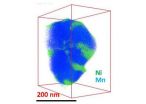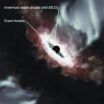(Press-News.org) The deserts of Utah and Nevada have not always been dry. Between 14,000 and 20,000 years ago, when large ice caps covered Canada during the last glacial cooling, valleys throughout the desert southwest filled with water to become large lakes, scientists have long surmised. At their maximum size, the desert lakes covered about a quarter of both Nevada and Utah. Now a team led by a Texas A&M University researcher has found a new water cycle connection between the U.S. southwest and the tropics, and understanding the processes that have brought precipitation to the western U.S. will help scientists better understand how the water cycle might be perturbed in the future.
Mitch Lyle, professor of oceanography, led the study with colleagues from Columbia University, University of California-Santa Cruz, Stanford University, Hokkaido University of Japan, Brown University and the U.S. Geological Survey. Their work, funded by the National Science Foundation, is published in the current issue of Science magazine.
The dry shorelines of these glacial lakes were first discovered by 19th century geologists when the west was first explored, Lyle explains, adding that the source of the additional water has been a mystery. By assembling data from ocean sediments and from dry western valleys collected over the last 30 years, Lyle and the team found a new water cycle connection between the southwest U.S. and the tropics.
"Large ice caps profoundly altered where storms went during glacial periods. Before this study, it was assumed that Pacific winter storms that now track into Washington and Canada were pushed south into central and southern California," Lyle notes.
"However, by comparing timing between wet intervals on the coast, where these storms would first strike, with growth of the inland lakes, we found that they didn't match."
The team was able to time wet periods along the California coast from pollen buried in marine sediments from cores archived by scientists at the Integrated Ocean Drilling Program at Texas A&M. They evaluated lake level studies from southeast Oregon, Nevada, Utah, eastern California, New Mexico, and west Texas to find when lakes filled in different parts of the west.
"Many teams of scientists have been working on this problem since the 1950s, when radiocarbon dating first allowed ages to be put on old shorelines," Lyle adds. "The data we synthesized covers a wide latitude so that we could determine how the glacial wet intervals operated."
Only southern California coastal wet intervals matched with the progression of high lakes inland, pointing to the development of a tropical connection, where storms cycled into the region from the tropical Pacific, west of southern Mexico.
"We think that the extra precipitation may have come in summer, enhancing the now weak summer monsoon in the desert southwest. But we need more information about what season the storms arrived to strengthen this speculation," Lyle says.
Not only is the development of the glacial lakes important from a paleoclimate perspective, but it is likely that the lakes were important to the migration of people into North America, Lyle believes.
Many of the archaeological sites where early Indians settled when they first came into the U.S. are rock shelters at the edges of these ancient lakes. The lakes were a major source of fish, and a gathering place for deer and wildfowl at that time.
"What we need to do now is look at all of this on a finer scale," Lyle points out. "We need to understand better the processes that directed the storms thousands of years ago, and to predict better what changes might occur in the future."
###
About Research at Texas A&M University: As one of the world's leading research institutions, Texas A&M is in the vanguard in making significant contributions to the storehouse of knowledge, including that of science and technology. Research conducted at Texas A&M represents an annual investment of more than $700 million. That research creates new knowledge that provides basic, fundamental and applied contributions resulting in many cases in economic benefits to the state, nation and world.
Media contact: Keith Randall, News & Information Services, at (979) 845-4644 or keith-randall@tamu.edu or Mitch Lyle at (979) 845-3380 or mlyle@ocean.tamu.edu
More news about Texas A&M University, go to http://tamutimes.tamu.edu/
Follow us on Twitter at http://twitter.com/tamu/
New clues about ancient water cycles shed light on US deserts, says Texas A&M-led study
2012-09-28
ELSE PRESS RELEASES FROM THIS DATE:
Peering to the edge of a black hole
2012-09-28
Using a continent-spanning telescope, an international team of astronomers has peered to the edge of a black hole at the center of a distant galaxy. For the first time, they have measured the black hole's "point of no return" - the closest distance that matter can approach before being irretrievably pulled into the black hole.
A black hole is a region in space where the pull of gravity is so strong that nothing, not even light, can escape. Its boundary is known as the event horizon.
"Once objects fall through the event horizon, they're lost forever," says lead author ...
New fish species offers literal take on 'hooking up'
2012-09-28
Fishing hooks aren't the only hooks found in east-central Mexican waters.
A new species of freshwater fish described by a North Carolina State University researcher has several interesting – and perhaps cringe-inducing – characteristics, including a series of four hooks on the male genitalia.
Females of the new species – the llanos mosquitofish, or Gambusia quadruncus – also have distinguishing characteristics, including a colorful anal spot.
A paper describing the new species, which lives in a diversity hotspot and seemingly branched off from its closest relative ...
Deadly complication of stem cell transplants reduced in mice
2012-09-28
Studying leukemia in mice, researchers at Washington University School of Medicine in St. Louis have reduced a life-threatening complication of stem cell transplants, the only curative treatment when leukemia returns.
About 50 percent of leukemia patients who receive stem cells from another person develop graft-versus-host disease, a condition where donor immune cells attack the patient's own body. The main organs affected are the skin, liver and gut. Now, the scientists have shown they can redirect donor immune cells away from these vital organs. Steering immune cells ...
Nickelblock: An element's love-hate relationship with battery electrodes
2012-09-28
RICHLAND, Wash. -- Anyone who owns an electronic device knows that lithium ion batteries could work better and last longer. Now, scientists examining battery materials on the nano-scale reveal how nickel forms a physical barrier that impedes the shuttling of lithium ions in the electrode, reducing how fast the materials charge and discharge. Published last week in Nano Letters, the research also suggests a way to improve the materials.
The researchers, led by the Department of Energy's Pacific Northwest National Laboratory's Chongmin Wang, created high-resolution 3D ...
Measuring the universe's 'exit door'
2012-09-28
CAMBRIDGE, MA -- The point of no return: In astronomy, it's known as a black hole — a region in space where the pull of gravity is so strong that nothing, not even light, can escape. Black holes that can be billions of times more massive than our sun may reside at the heart of most galaxies. Such supermassive black holes are so powerful that activity at their boundaries can ripple throughout their host galaxies.
Now, an international team, led by researchers at MIT's Haystack Observatory, has for the first time measured the radius of a black hole at the center of a distant ...
World's first glimpse of a black hole 'launchpad'
2012-09-28
A strange thing about black holes: they shine.
The current issue of Science Express features a paper by the Event Horizon telescope team – a collaboration that includes Avery Broderick, Associate Faculty at Perimeter Institute – that may shed light on the origin of the bright jets given off by some black holes. In a world first, the team has been able to look at a distant black hole and find out where its jets are launched from: the "launchpad".
Many galaxies, including our own Milky Way, have a huge black hole lurking at their cores. In about 10 percent of such galaxies, ...
Newspaper sales suffer due to lack of stimulating content
2012-09-28
Los Angeles, CA (September 27, 2012) – Since the newspaper industry started to experience a major decrease in readership in recent years, many people have deemed the internet and other forms of new media as the culprits. However, a recent study published in the Journalism & Mass Communication Quarterly, a SAGE Journal, finds that sales are down because readers need more engaging and stimulating content.
Study authors Rachel Davis Mersey, Edward C. Malthouse, and Bobby J. Calder suggested that it is crucial for journalists and practitioners to focus their efforts on creating ...
Researchers investigate aggression among kindergartners
2012-09-28
UNIVERSITY PARK, Pa. -- Not all aggressive children are aggressive for the same reasons, according to Penn State researchers, who found that some kindergartners who are aggressive show low verbal abilities while others are more easily physiologically aroused. The findings suggest that different types of treatments may be needed to help kids with different underlying causes for problem behavior.
"Aggressive responses to being frustrated are a normal part of early childhood, but children are increasingly expected to manage their emotions and control their behavior when ...
Liver cells, insulin-producing cells, thymus can be grown in lymph nodes, Pitt team finds
2012-09-28
PITTSBURGH, Sept. 27, 2012 – Lymph nodes can provide a suitable home for a variety of cells and tissues from other organs, suggesting that a cell-based alternative to whole organ transplantation might one day be feasible, according to researchers at the University of Pittsburgh School of Medicine and its McGowan Institute for Regenerative Medicine. In a report recently published online in Nature Biotechnology, the research team showed for the first time that liver cells, thymus tissue and insulin-producing pancreatic islet cells, in an animal model, can thrive in lymph ...
Genetic sleuthing uncovers deadly new virus in Africa
2012-09-28
An isolated outbreak of a deadly disease known as acute hemorrhagic fever, which killed two people and left one gravely ill in the Democratic Republic of Congo in the summer of 2009, was probably caused by a novel virus scientists have never seen before.
Described this week in the open-access journal PLoS Pathogens, the new microbe has been named Bas-Congo virus (BASV) after the province in the southwest corner of the Congo where the three people lived.
It was discovered by an international research consortium that included the University of California, San Francisco ...



